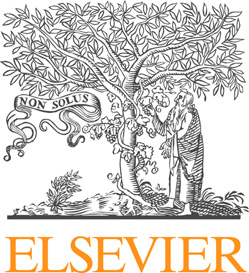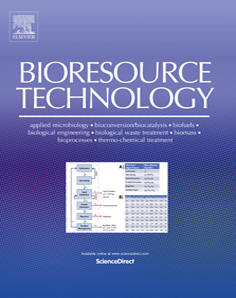|
Methods
2.1. Wastewater sampling and analysis
Wastewater collected from the inflow channels (of Bellandur lake, Koramangla region, South of Bangalore, India) was allowed to settle for 2 days. The supernatant was sterilised, filtered and used as the culture media (as per Zhou et al., 2012b). Wastewater used for culturing were analysed through standard protocols (APHA, 2005) and the parameters were pH 6.3 ± 0.1, redox potential (ORP) -163 mV, total volatile solids (TVS) 432 ± 66 mg/l, total suspended solids (TSS) 540 ± 84 mg/l. Similarly, the analysis of wastewater broth through HACH protocol yielded Total Organic Carbon (TOC) of 219 ± 14 mg/l, Chemical Oxygen Demand (COD) of 676 ± 17.2 mg/l, Total Nitrogen (TN) of 64.6 ± 4.2 mg/l, Nitrate-Nitrogen (NO3-N) of 1.07 ± 0.15 mg/l, Nitrite-Nitrogen (NO2-N) of 0.32 ± 0.04 mg/l, Ammonium-Nitrogen (NH4-N) of 51.5 ± 5.5 mg/l, Total Phosphorus (TP) of 28 ± 4.3 mg/l and Ortho-phosphates (OP) of 22.2 ± 2.4 mg/l.
2.2. Culturing algal consortia and growth conditions and reactor design
Algal samples were collected from wastewater fed urban lakes. From these samples, algal species were identified by morphological keys using the light and electron microscopes. The water sample collected from the lake was centrifuged at 1816g and the algal pellet containing the algal consortia was washed and centrifuged repeatedly with deionised water. Subsequently, the algal cells were inoculated in Bolds Basal (BB) media. The algal consortia grown in BB media comprised of bacillariophyceae (Cyclotella meneghiniana, Nitzschia palea), chlorophyceae (Chlorococcum sp., Scenedesmus quadricauda, Scenedesmus obliques, Arthrodesmus curvatus, Golenkinia radiata, Kirchneriella lunaris, Chlorella vulgaris, Chlorella pyrenoidosa, Chlorococcum humicola, Chroococcus sp., Monoraphidium sp., Ankistrodesmus falcatus), cyanophyceae (Oocystis sp., Phormidium tenue, Spirulina maximus) and euglenophyceae (Trachelomonas spp., Euglena spp., Phacus longicauda, Phacus caudatus). Inoculum comprising of these algal consortia were then added to the reactor (~106 cells/ml; inoculum volume 40 ml; reactor working volume 10 L).
The algal reactor was made up of translucent polypropylene with a storage capacity >12 l (measuring 32 cm × 16 cm × 24 cm depth; working volume 10 L), covered with a glass sheet (the spacing between the glass sheet and the reactor was 20 cm). The reactor was kept on rooftop with a direct access to sunlight (light: dark period of 12 h: 12 h), and the culture was mixed uniformly thrice a day at regular intervals. The diurnal illuminance was recorded at the horizontal surface of the reactor using a lux meter. Illuminance ranges from 600 lux (during sunrise and sunset) to ~1,00,000 lux (during the mid-day). Algal cultures were maintained at ambient temperatures (22–30 °C) and the growth was monitored daily for two weeks. 100 ml of broth was collected daily and centrifuged. The reactor volume was maintained at 10 L with deionised water (to compensate evaporation losses and also 100 ml of broth). The filtered supernatant from centrifuged broth was used for nutrient analysis. The algal pellet was subjected to repeat washing following which it was dried and weighed (dry weight). Subsequently, the total lipid content, spectroscopic and elemental analyses were conducted. Algal biomass concentration (cell dry weight in the culturing medium in terms of g/l) was estimated by gravimetry.
2.3. Growth, productivity and lipid measurements
The probable model for biomass growth in 12 days is given by Eq. (1).
B2 = B1 e SGR(T2-T1) --------------------------------------(1)
where T2–T1 (day) represents the time difference between the two measurements,
B2 and B1 (g/L) represent the concentration of biomass at T2 (12th day) and T1 (1st day), respectively. SGR – specific growth rate helps in estimating likely biomass on the nth day.
The biomass productivity (Bprod) during culturing is given by Eq. (2)
Bprod= (B2-B1) / T2-T1 ---------------------------------------(2)
where, Bprod is the biomass productivity (g/l/d), T2–T1 (day) represents the time difference between the two measurements, B2 and B1 (g/l) represent the concentration of biomass at T2 (12th day) and T1 (1st day), respectively.
Cell suspensions were pelletised through centrifugations at 7267g for 10 min, and stored at −20 °C for further use. Lipids from these pellets were extracted through Bligh Dyer’s method which included solvent extraction followed by gravimetric analysis. The total lipid content of the algal biomass is given by Eq. (3).
LC = LW / Bw---------------------------------------------------(3)
where, LC is the quantity of total lipid per unit of algae (g/g), LW is lipid weight in grams (g), Bw is dry weight of algal biomass in grams (g).
Similarly, lipid productivity is given by Eq. (4).
Lprod.= (LC2B2-LC1B1) / (T2-T1) ------------------------------------------(4)
where, Lprod. = lipid productivity per litre of wastewater per day (g/l/d), LC2 and LC1 are the respective total lipid content of algae (g/g) at times T2 (12th day) and T1 (1st day). Similarly, B2 and B1 are the respective biomass (g) at times T2 (12th day) and T1 (1st day).
2.4. Composition analysis – Fourier Transform Infrared Spectroscopy (FTIR)
Attenuated total reflectance ATR-FTIR spectra were obtained to assess the composition of algal biomass based on bio-molecular functionalities. Freeze dried pulverised algal daily samples were observed through IR spectra in the Mid IR range (64 scans, wave number 4000–800 cm−1 and spectral resolution of 2 cm−1) and data were analysed using Origin Pro 8 SR0, v8.0724 (B724) with an initial base line correction, and scaled up to Amide Imax (as per Stehfest et al., 2005). Spectral curves were fitted based on Gaussian distribution considering peak values with area for each being computed. The biochemical transitions in the algal cells were monitored by the analysis of carbohydrate to protein (C/P); lipid to protein (L/P) and lipid to phosphate (L/Phos.) ratio (as per Stehfest et al., 2005). In the spectrogram, ~1740 cm−1 represented ν(C O) ester groups (based on stretching vibrations) primarily from lipids and fatty acids; similarly, ~1655 cm−1 represented ν(C O) ester groups (based on stretching vibrations) primarily from lipids and fatty acids; similarly, ~1655 cm−1 represented ν(C O) amides from proteins (Amide I); ~1240 cm−1 represented νas(>P O) amides from proteins (Amide I); ~1240 cm−1 represented νas(>P O) phosphoric compounds and ~1000 cm−1 represented ν(C-O-C) stretching from polysaccharides. Compared to these, ~1545 cm−1 represented δ(N–H) amides from proteins (Amide II) based on bending vibrations. O) phosphoric compounds and ~1000 cm−1 represented ν(C-O-C) stretching from polysaccharides. Compared to these, ~1545 cm−1 represented δ(N–H) amides from proteins (Amide II) based on bending vibrations.
2.5. Elemental analysis and imaging: SEM-EDXA field emission scanning electron-microscopy
Algal cell imaging involves (i) fixing algal cells in 2.5% of glutaraldehyde, (ii) dehydration by ethanol (from 30% till 100% concentration), (iii) drying algal cells, (iv) mounting on carbon tapes (over aluminium stub), gold-sputtered and (v) observation and imaging using FEI ESEM Quanta 200 and FEI Sirion XL30 FEG SEM (in the ultra high range) with a schottky field emission source with high voltage variable between 200 V and 300 kV. EDS Detector EDAX Genesis with working resolution of 0.5 nm at >10 kV, 2.5 nm at 1 kV, 3.5 nm at 500 V with accelerating voltage, 2–30 kV were used for elemental analysis.
2.6. Fatty acid (FAME) composition analysis through GCMS
Algal fatty acid composition determination comprised of (i) cell disruption, done by ultra-sonication using ultrasonic bath (frequency 35 kHz) for 30 min, (ii) extraction of lipid with chloroform–methanol (2:1, v/v) and (iii) determination of total lipids through Bligh and Dyer's method (1959). Methylation of lipids was performed using Boron-trifluoride–Methanol (BF3–MeOH) that yields corresponding methyl esters from fatty acids. FAME composition was assessed through gas chromatograph mass spectrometry (Agilent Technologies 7890C, GC System; Agilent Technologies 5975C insert MSD with Triple-Axis Detector) with helium gas as carrier in split-less mode. The components were identified based on their retention times, abundance and fragmentation patterns by comparing them with a known standard.
2.7. Thermal analysis – differential scanning calorimetry (DSC)
Thermal analysis was done with METTLER-TOLEDO DSC1 instrument in N2 atmosphere (30–50 mL/min) to determine energy transitions (exothermic/endothermic) and thermal behaviour. Samples include (a) algal matter, (b) spent algal matter after lipid extraction, (c) algal mass floc floating on the surface of the reactor and (d) settled sludge in the reactor. 5–10 mg samples placed in 40 μg aluminium crucibles were heated up to 500 °C at a constant heating rate of 10 °C/min. DSC thermograms were analysed for energy values with the help of Lab METTLER STAR 9.3 and Origin Pro 8 software.
|



